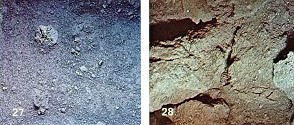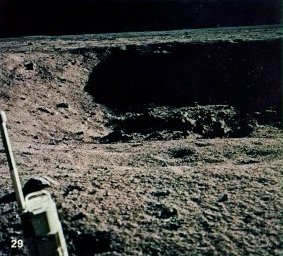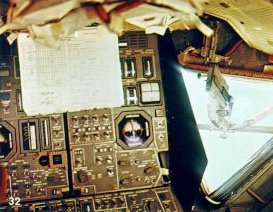















|
 |
 |
|
ARMSTRONG After reentering the LM, we could see the effects of our activity on the surface. (Photo 30.) You'll note that the surface looks considerably darker in the area where the majority of the walking took place. However, on the left side of the picture, where it is not as dark, there was also a good bit of walking. That indicates that the walking probably just increases your ability to notice the effects of the strange lighting that Buzz talked about earlier, where the cross-Sun lighting is a good bit darker than the down-Sun lighting. ALDRIN Following the EVA, we had a sleep period, which in a word, didn't go quite as well as we thought it might. We found it was quite difficult to keep warm. When we pulled the window shades over the windows, we found that the environment within the cabin chilled considerably and after about two or three hours, we found that it was rather difficult for us to sleep. You see mounted in the right hand window, the 16-millimeter camera (Photo 31), that was mounted for taking the pictures on the surface. Following the sleep period, as we're approaching the lift-off point we progressed with a gradual power-up of the lunar module, which included another star alignment check and as Mike came over in Columbia, one revolution before lift-off, we used the radar to track him as he went over. We continued the check out. You see here, one of the data books that's mounted up in front of the instrument panel (Photo 32), that was used to record the various messages that were sent up to us, a whole host of numbers, for the particular maneuvers that were coming up, that we would copy down. We would log these on that sort of a data sheet. |
|
 |
 |
 |
 |